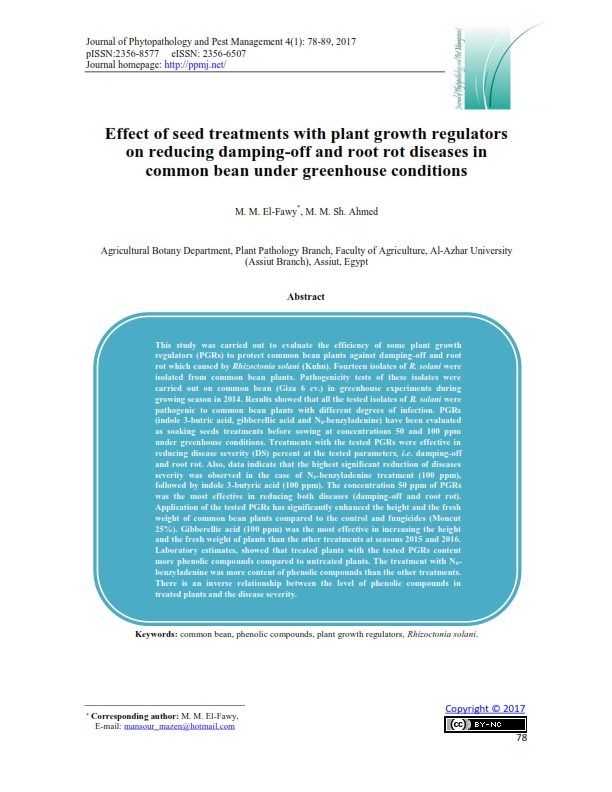Effect of seed treatments with plant growth regulators on reducing damping-off and root rot diseases in common bean under greenhouse conditions
Keywords:
common bean, phenolic compounds, plant growth regulators, Rhizoctonia solani.Abstract
This study was carried out to evaluate the efficiency of some plant growth regulators (PGRs) to protect common bean plants against damping-off and root rot which caused by Rhizoctonia solani (Kuhn). Fourteen isolates of R. solani were isolated from common bean plants. Pathogenicity tests of these isolates were carried out on common bean (Giza 6 cv.) in greenhouse experiments during growing season in 2014. Results showed that all the tested isolates of R. solani were pathogenic to common bean plants with different degrees of infection. PGRs (indole 3-butric acid, gibberellic acid and N6-benzyladenine) have been evaluated as soaking seeds treatments before sowing at concentrations 50 and 100 ppm under greenhouse conditions. Treatments with the tested PGRs were effective in reducing disease severity (DS) percent at the tested parameters, i.e. damping-off and root rot. Also, data indicate that the highest significant reduction of diseases severity was observed in the case of N6-benzyladenine treatment (100 ppm), followed by indole 3-butyric acid (100 ppm). The concentration 50 ppm of PGRs was the most effective in reducing both diseases (damping-off and root rot). Application of the tested PGRs has significantly enhanced the height and the fresh weight of common bean plants compared to the control and fungicides (Moncut 25%). Gibberellic acid (100 ppm) was the most effective in increasing the height and the fresh weight of plants than the other treatments at seasons 2015 and 2016. Laboratory estimates, showed that treated plants with the tested PGRs content more phenolic compounds compared to untreated plants. The treatment with N6-benzyladenine was more content of phenolic compounds than the other treatments. There is an inverse relationship between the level of phenolic compounds in treated plants and the disease severity.
Metrics

Published
How to Cite
Issue
Section
License
Authors who publish with Journal of Phytopathology and Disease Management agree to the following terms:
- Authors retain copyright and grant the journal right of first publication with the work simultaneously licensed under a Creative Commons Attribution License that allows others to share the work with an acknowledgement of the work's authorship and initial publication in this journal.
- Authors retain copyright and grant the journal right of first publication with the work simultaneously licensed under the Creative Commons Attribution-Non Commercial License (CC BY-NC). This allows others to share the work with an acknowledgement of the work's authorship and initial publication in this journal.
- Archives of Agricultural Sciences Journal is an Open Access Journal, and articles published are distributed under the terms of the Creative Commons Attribution-Non Commercial License (CC BY-NC). Readers may copy, distribute, and display the work for non commercial purposes with the proper citation of the original work. However, the journal retains the right to exploit subsidiary rights on behalf of the authors.
- Authors are able to enter into separate, additional contractural arrangements for the non-exclusive distribution of the journal's published version of the work (e.g. post it to an institutional repository or publish it in a book), with an acknowledgement of its initial publication in this journal.
- Authors are permitted and encouraged to post their work online (e.g., in institutional repositories or on their website) prior to and during the submission process with full disclosure to the journal, as it can lead to productive exchanges, as well as earlier and greater citation of published work. Following publication in Archives of Agricultural Sciences Journal, the author should update the repository, and include a citation and link to the published work.
Click here for more information on Licensing policy
.png)




